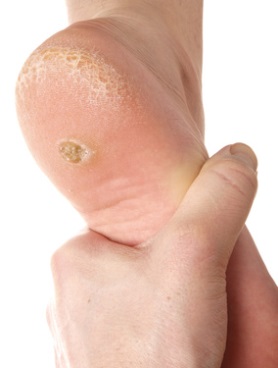A deep plantar wart is simply a wart on the sole (plantar) of the foot that has grown inward. Because simple acts like standing and walking put pressure on a plantar wart, they often look flat, unlike warts on the hands or other parts of the body, which are usually bumpy. Because of the pressure applied to them, plantar warts often grow inward instead of outward. We’ll tell you all about plantar warts, and since they can be painful, we’ll also tell you about methods of getting rid of plantar warts.
What Causes a Deep Plantar Wart?
Plantar warts, like all warts, are caused by a virus, human papillomavirus, or HPV. Usually, the virus enters the body through a break in the skin. Sometimes all it takes is for the skin to be softened, the way it is when you get out of a hot tub or swimming pool. That’s why you can get warts on your feet from locker room floors where other people with warts on their feet have walked.
Of course, not everyone that is exposed to HPV gets warts. Your immune system may fight off the virus. Elderly people and those with compromised immune systems are the most susceptible HPV. Plenty of healthy young folks do end up with warts, though.
Plantar warts often grow deep into the foot as a result of the pressure from normal daily activities like walking. This makes them different than other types of warts and can also make them more painful.
Recognizing a Deep Plantar Wart
Deep plantar warts are often mistaken for calluses because they are similar in appearance. Both are usually flat with tough, thickened skin. Plantar warts may cause pain if you squeeze them, though, while calluses usually do not. You may also see tiny black specks in a wart, which are blood vessels.
With both plantar warts and calluses, you may feel as if you’re walking around with a small pebble in your shoe. Plantar warts often cause more pain than calluses do, though.
Calluses and plantar warts are not treated the same way. If you’re not sure whether you have a callus or a plantar wart, see your doctor or a podiatrist for a diagnosis.
Getting Rid of Plantar Warts

Warts are generally harmless and they often go away eventually without any treatment. However, since plantar warts often cause pain when standing or walking, people generally prefer to have them removed. There are many different methods of getting rid of plantar warts.
Salicylic acid – You can purchase salicylic acid over the counter for use at home. It’s a fairly effective treatment for warts with minimal side effects. It can take several weeks of daily use to remove warts completely, however.
Cantharidin – This is a prescription medication, usually applied by a doctor. It can cause some pain and more than one treatment may be required.
Cryotherapy – This is a medical term that refers to freezing off warts with liquid nitrogen. It is usually painful and more than one treatment may be required.
Surgery – A surgeon can perform surgery to cut out a deep plantar wart. There will probably be some post-operative pain and you may need to stay off your foot for a while after the surgery.
Natural Treatments For Plantar Warts
Many people prefer natural treatments for plantar warts because they carry a much lower risk of side effects, including pain. Our preferred natural treatment for almost any type of wart, including plantar warts, is Naturasil Wart Remover. It’s available without a prescription and contains all-natural ingredients like essential oils and a homeopathic remedy, Thuja Occidentalis 6X, which work together to remove warts painlessly. To learn more about our preferred natural remedy for plantar warts, just follow this link to the Naturasil Website.
Ref: Cleveland Clinic
